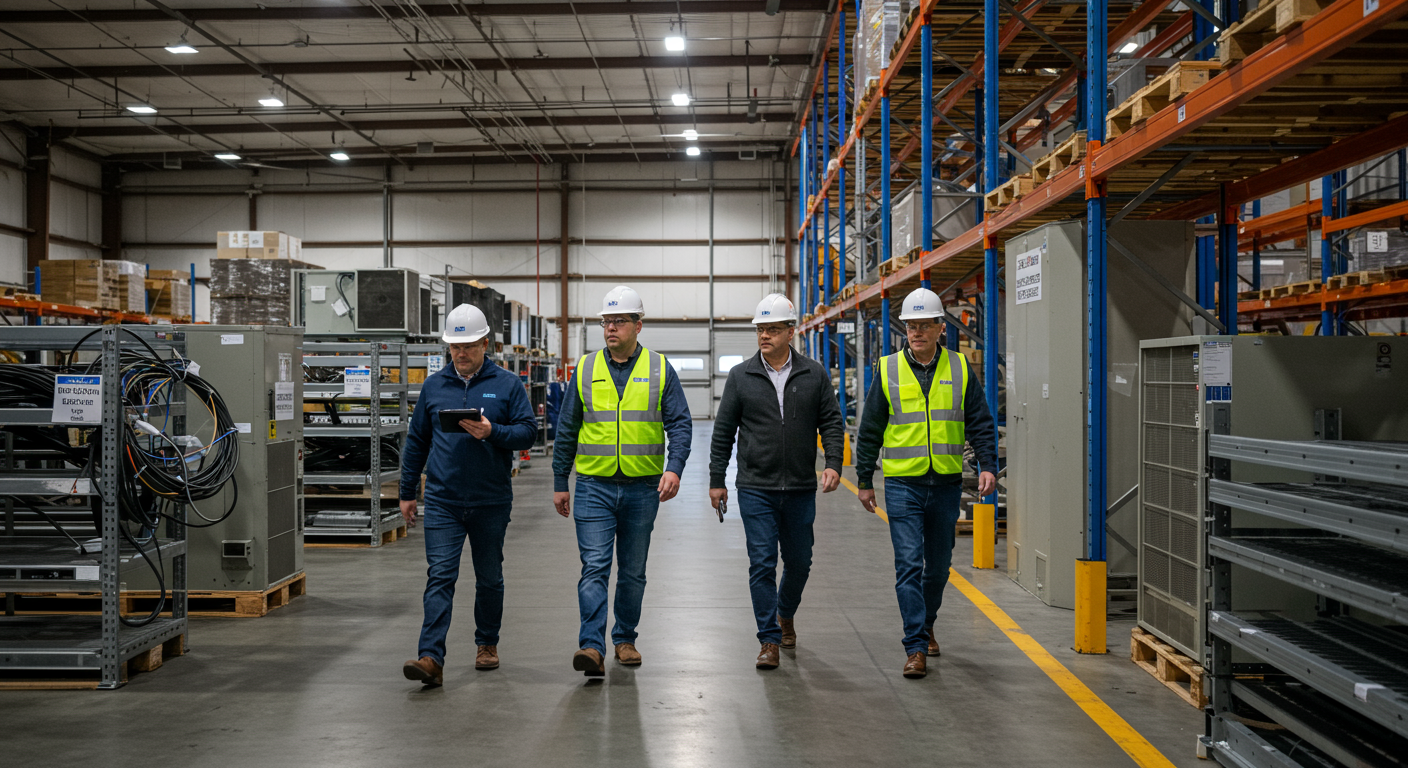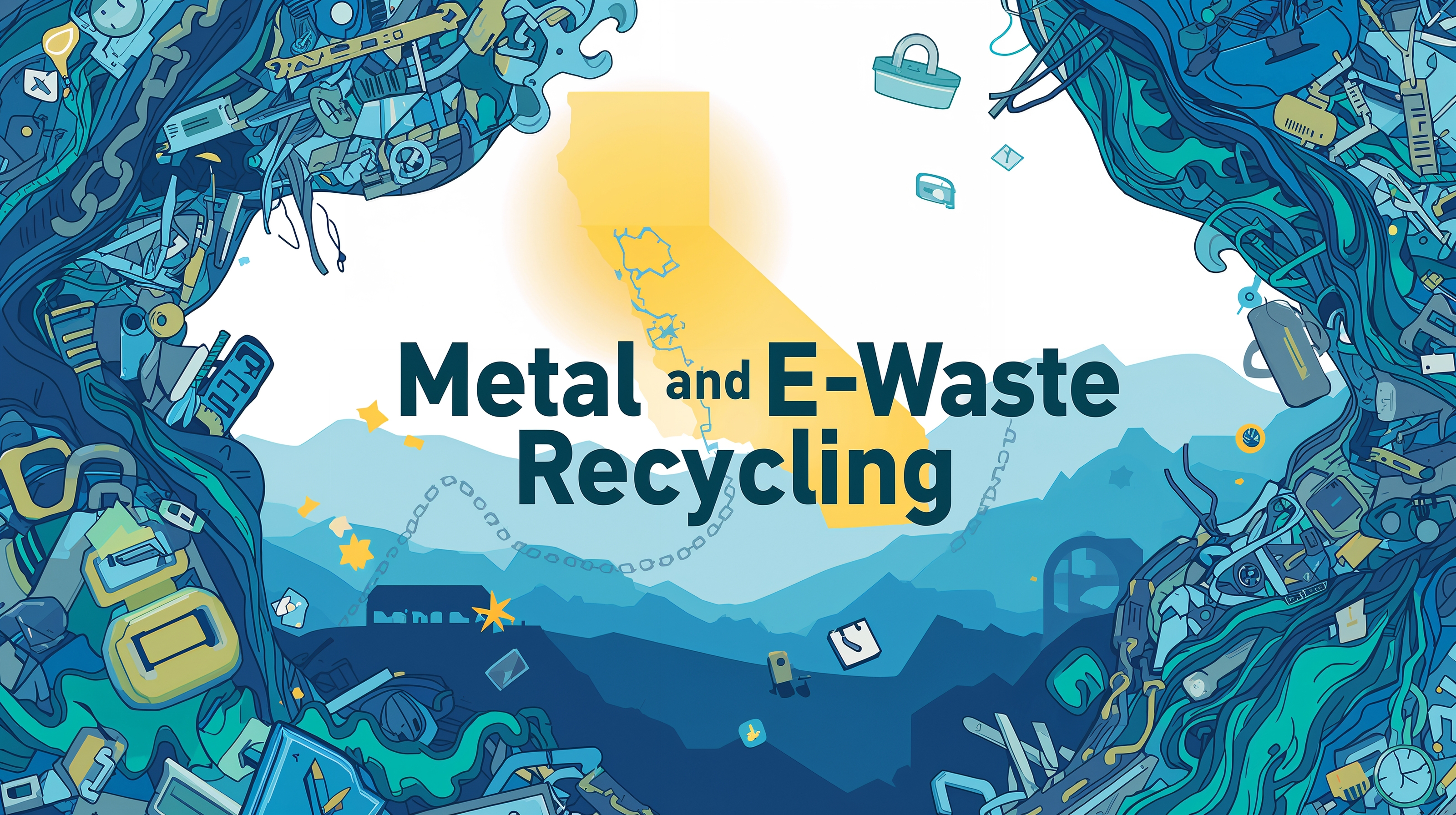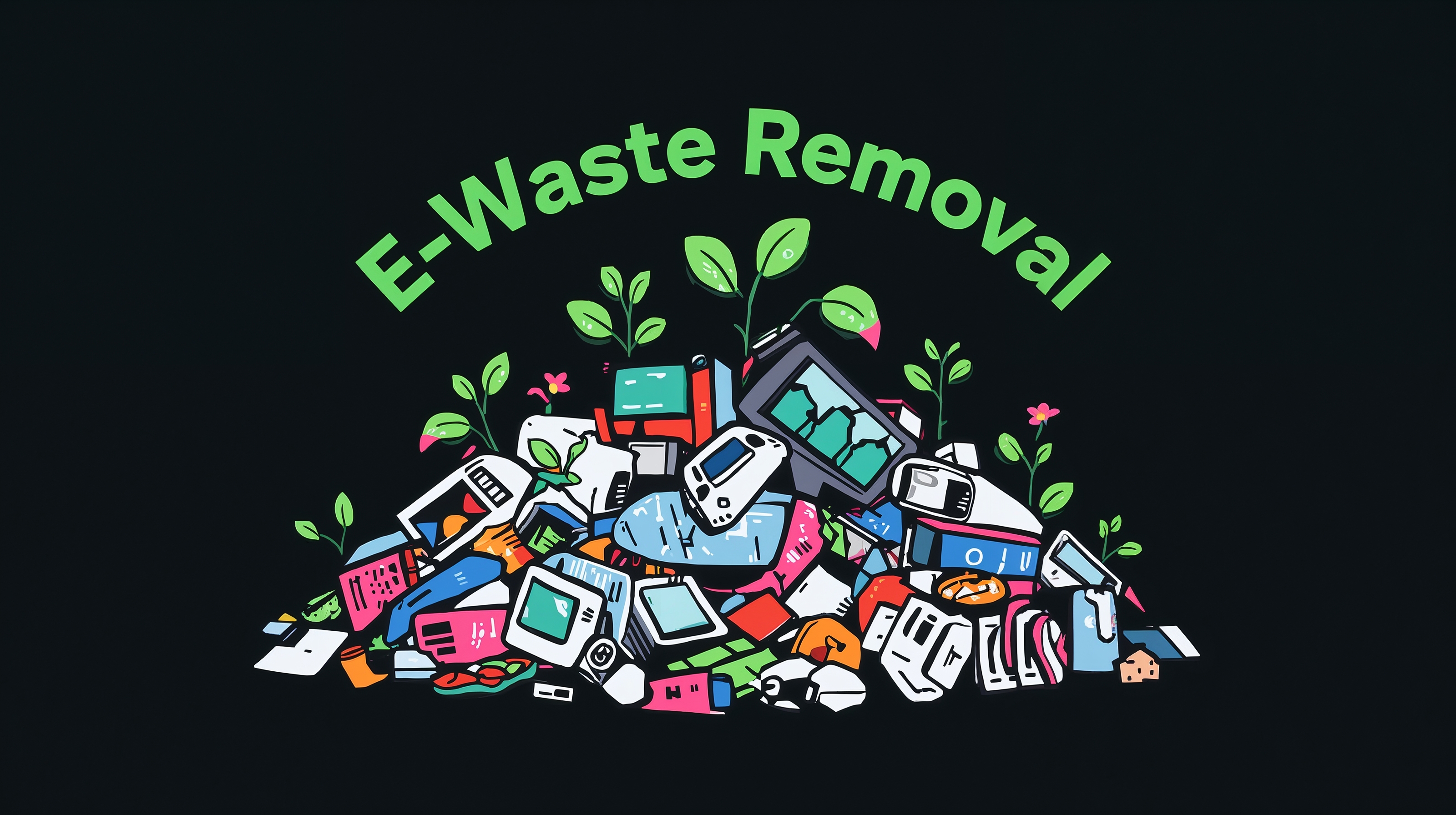Most facility managers only handle one or two decommissions in their entire career. That's part of what makes it so stressful.
Last fall, I spoke with a facilities director in San Jose who'd been managing a 75,000-square-foot warehouse for fifteen years. His company was consolidating operations, and suddenly he was responsible for clearing decades of accumulated metal racking, electronics, HVAC equipment, and wiring—all while his CFO kept asking about the move-out date and whether they'd have to pay another month's rent.
"I didn't even know where to start," he told me. "And every contractor I called gave me different answers about what was legal in California."
That conversation reflects what I've seen across Northern California over the past several years: facility decommission recycling in California catches people off guard because it sits at the intersection of logistics, compliance, and tight deadlines. Get it wrong, and you're facing project delays, regulatory violations, or leaving money on the table through poor scrap management.
California's regulatory framework makes this particularly challenging. The state classifies electronic waste as hazardous material under universal waste regulations, requiring specific handling procedures.[1] Meanwhile, scrap metal represents both a compliance obligation and a potential revenue opportunity that many facilities miss entirely.
This guide draws on what actually works when decommissioning and recycling commercial facilities in California—from initial assessment through final documentation—with realistic timelines and the compliance details that matter.
Why Decommissioning Projects Go Sideways
Three factors consistently derail facility decommission recycling California projects:
Underestimating the timeline. Most projects need 4-8 weeks from planning through closeout. Rush it, and you'll pay premium rates for expedited service or skip documentation steps that come back to haunt you during audits.
Treating it like regular waste removal. California's Electronic Waste Recycling Act of 2003 established the Covered Electronic Waste Recycling Program,[2] which means you can't just rent a dumpster and start throwing things away. Any device with a screen larger than four inches—computers, monitors, tablets—requires certified handling.[3]
Picking partners based solely on price. The lowest bid often comes from contractors who cut corners on documentation or lack proper certifications. When Morgan Stanley switched vendors to save $100,000 on a data center decommission, subcontractors failed to destroy data properly before reselling devices. The total financial impact? Over $155 million across multiple fines and settlements—including a $60 million OCC penalty, a $35 million SEC fine, and a $60 million class action settlement.[4][5]
Assessment: Knowing What You're Actually Dealing With
Before scheduling any pickups, walk your space like you're conducting a forensic investigation.
Start in the obvious places—server rooms, warehouse floors, break areas. Then check the spots everyone forgets: above ceiling tiles, utility closets, mezzanine storage, exterior equipment pads, loading dock areas. One Oakland facility I worked with discovered 18 obsolete HVAC units on their roof that nobody had documented in the decommission plan.
Document everything that needs removal:
Metal infrastructure (racking, shelving, structural components)
IT equipment and electronics
HVAC systems and ductwork
Furniture with metal frames
Exposed wiring and cabling
Manufacturing or processing equipment
Battery backup systems
For electronics, photograph serial numbers and asset tags. This matters more than you'd think—chain-of-custody documentation starts with accurate inventory, and California requires detailed records of e-waste disposal activities including device types, quantities, and recycler identity.[6]
The Compliance Landscape
California doesn't make this simple. Different materials trigger different regulatory frameworks.
The Department of Toxic Substances Control (DTSC) regulates scrap metal facilities and requires hazardous waste manifests for certain materials.[7] CalRecycle manages the Covered Electronic Waste program and maintains a list of certified recyclers.[8] Cal/OSHA mandates workplace safety standards during demolition and removal work.[9]
This is why picking the right recycling partner matters so much. They should know which regulations apply to your specific materials and location—because California's requirements vary not just by material type but sometimes by jurisdiction.
Finding Partners Who Won't Become Your Biggest Problem

When selecting contractors, prioritize those experienced in facility decommission recycling California standards. They should demonstrate expertise in both logistics and compliance—managing metals, electronics, and hazardous materials under DTSC and CalRecycle regulations.
I've seen facilities hire recyclers who show up unprepared, can't handle both metals and electronics, or disappear for weeks without communication. Here's what actually predicts a smooth project:
Dual-stream capability. Your facility contains both metals and electronics. Working with separate contractors for each material stream doubles your coordination headaches and extends your timeline. A partner who handles both streamlines everything.
Real chain-of-custody systems. Ask to see examples of their documentation. Chain-of-custody tracking begins when materials leave your facility and continues through every processing stage.[10] You want serialized tracking, detailed transfer records, and certificates that would hold up in an audit.
Look for recyclers with R2 (Responsible Recycling), e-Stewards, or ISO certifications.[11] These aren't just marketing badges—they represent regular third-party audits of safety, environmental, and documentation practices.
Statewide presence matters for multi-site projects. If you're consolidating several California locations, you need a partner who can coordinate pickups across regions without treating each site as a separate project.
The best indicator of reliability? Ask for references from similar-scale projects, then actually call them. Ask about response times, documentation quality, and whether the contractor hit promised timelines.
Metal Removal: Sequencing Prevents Rework
Here's a mistake I see repeatedly: facilities pull out electronics first, then realize the metal racking and shelving they need to remove was supporting all that equipment.
Think through the dependency chain. Server racks hold servers. Workstation desks support monitors. Mezzanine structures might have electrical panels mounted to them. Remove items in the wrong order, and you create safety hazards or double the labor time.
Most commercial facilities in California contain several metal categories, each with different handling requirements and market values:
Structural steel includes racking systems, I-beams, and support structures. It's heavy, requires proper equipment for safe removal, and makes up the majority of weight in most decommissions.
Aluminum appears in window frames, HVAC components, electrical conduit, and architectural features. It's lighter than steel but commands higher per-pound prices in scrap markets.
Copper is where value concentrates—wiring, pipes, HVAC coils, and electrical components. Professional recyclers can evaluate copper by grade, which significantly impacts pricing. Insulated copper wire, for instance, receives different treatment than bare bright copper.
Stainless steel and brass show up in fixtures, specialty equipment, and hardware.
Proper staging helps recyclers work efficiently and often results in better evaluations. That doesn't mean you need to disassemble everything—they have equipment for that—but basic segregation pays off. Keep ferrous metals (magnetic) separate from non-ferrous when practical. Remove obvious non-metal attachments. Provide clear access paths for loading equipment.
Safety protocols matter more than speed. California's Division of Occupational Safety and Health requires lockout/tagout procedures for any active systems, proper PPE for all workers, and specific protocols around cutting or welding operations.[12] Cutting corners here creates liability that no timeline pressure justifies.
E-Waste Removal: Where Compliance Gets Expensive
Data security is non-negotiable, and the consequences of getting it wrong are steep.
California's Consumer Privacy Act (CCPA) imposes strict data protection requirements on businesses handling personal information.[13] That includes the data sitting on decommissioned computers, servers, and mobile devices.
You have two main options for data destruction: on-site witnessing or certified off-site processing with proper documentation. On-site services let you watch drives get physically destroyed before equipment leaves your building. It costs more but provides immediate verification. Off-site destruction is cheaper but requires absolute trust in your vendor's chain-of-custody processes and certification documentation.
Data destruction certificates should reference industry standards—NIST 800-88 or DoD 5220.22-M are the benchmarks.[14] These aren't just suggestions; they're what auditors and courts look for when evaluating whether you met your due diligence obligations.
What California Defines as E-Waste
The state's definition of Covered Electronic Devices (CEDs) includes products with video display screens larger than four inches measured diagonally.[15] This covers:
Computer monitors and all-in-one systems
Laptops and tablets
Televisions
Digital signage displays
But responsible decommissioning should also handle:
Desktop computers and servers
Networking equipment (switches, routers)
Printers and multifunction devices
UPS battery systems
Peripherals (keyboards, mice, external drives)
Electronics contain lead, mercury, cadmium, and brominated flame retardants—all classified as hazardous materials under California law.[16] When these materials end up in landfills, they leach into groundwater and soil. That's why California prohibits disposing of e-waste in regular trash and requires certified recycling.
Inventory and Documentation Requirements
Create detailed manifests as items leave your facility. For each device type, track:
Make and model
Serial numbers or asset tags
Quantity
Pickup date and time
Destination facility
Chain-of-custody documentation
This level of detail isn't bureaucratic overkill—it's what California regulations require for compliance.[17] Facilities must maintain records showing the type and quantity of e-waste recycled, dates of disposal, and the identity of certified recyclers used. These records need to be kept for at least three years, though five years is recommended for comprehensive protection.
Documentation and Closeout: The Part Nobody Wants to Do

The decommission isn't finished when the last truck leaves. Proper closeout prevents problems months or years later.
California requires specific documentation for both metals and electronics:
For e-waste: type and quantity logs, disposal dates, certified recycler information, destruction certificates, and weight tickets where applicable.[18]
For metals: weight tickets from certified scales, settlement statements, manifests for any hazardous materials.
For both: complete chain-of-custody documentation showing transfer of materials from your facility through final processing.[19]
Keep copies of everything. Store electronic versions in multiple locations. If your organization faces an environmental audit or data breach investigation years from now, these records prove you followed proper procedures.
Before considering a space decommissioned, complete a final walk-through:
Check every area against your initial inventory
Inspect spaces that are easy to miss (ceiling cavities, exterior pads, utility rooms)
Photograph the cleared space
Get sign-off from property management if your lease requires it
I've seen facilities lose deposit money because they missed equipment in ceiling spaces or exterior areas during their final inspection.
For any facility decommission recycling California project, documentation is your ultimate safeguard. Keep manifests, destruction certificates, chain-of-custody logs, and weight tickets. These records protect your organization during environmental audits and ensure regulatory compliance long after the project ends.
Multi-Site Coordination Strategies
Consolidating several California locations simultaneously? The complexity multiplies, but you can manage it systematically.
Use standardized documentation templates across all sites. When every facility follows the same inventory format, staging procedures, and reporting structure, you can spot issues faster and compare progress accurately.
Work with your recycling partner to optimize regional routing. Group pickups geographically where possible. A recycler servicing facilities in Sacramento, Stockton, and Modesto on consecutive days is more efficient than treating each as a separate mobilization. This often translates to better pricing and faster service.
Centralize your documentation management. One person or team should maintain all chain-of-custody records and compliance documentation. This prevents gaps and ensures nothing falls through the cracks when you're managing multiple concurrent projects.
California isn't uniform in its local requirements. Urban facilities in San Francisco or Los Angeles may have additional municipal waste ordinances beyond state regulations. Your recycling partner should flag these location-specific requirements.
Timeline Reality Check
Here's what actually happens in practice:
Most professional facility decommissions in California take 4-8 weeks from initial planning through final documentation. Smaller offices might compress this to 3-4 weeks. Larger industrial facilities sometimes stretch to 10-12 weeks depending on complexity.
The variables that extend timelines:
Access restrictions (nights/weekends only, limited loading dock availability)
Specialized equipment requiring certified handling
Multi-building campuses
Contaminated materials needing special permits
Concurrent operations that can't be disrupted
Variables that accelerate projects:
Clear dock access and staging areas
Single-story facilities
Pre-segregated materials
Flexible scheduling
Complete upfront documentation
Start planning at least six weeks before your required move-out date. Eight weeks is safer if your facility is over 20,000 square feet or contains substantial equipment.
Common Mistakes and How to Avoid Them
Waiting until the last minute. I've worked with facilities that called two weeks before their lease expired, expecting immediate mobilization. Sometimes we can accommodate that, but you'll pay premium rates and have limited choice in scheduling.
Incomplete initial surveys. Missing equipment during your assessment creates schedule delays when you discover it later. Do multiple walk-throughs. Bring someone who knows the building's history.
Choosing partners without verifying certifications. California's regulations exist for reasons. Working with uncertified recyclers puts you at risk for violations even if you didn't know they were cutting corners.
Skipping data destruction. This is where the Morgan Stanley case is instructive. They hired a vendor who subcontracted to an e-scrap processor. The subcontractor didn't destroy data as contracted. Devices got resold with client information intact. The total penalties exceeded $155 million when you count the $60 million OCC fine, $35 million SEC penalty, and $60 million class action settlement.[20][21]
Poor documentation practices. Trying to recreate chain-of-custody records months after the fact is nearly impossible. Document everything in real-time.
Ignoring value recovery. Commercial-grade metals have market value. The difference between haphazard disposal and proper scrap management can be significant—particularly for facilities with substantial copper, aluminum, or stainless steel components.
Regulatory Complexity Worth Understanding
California's regulatory landscape continues evolving. The DTSC periodically updates requirements for metal shredding facilities and scrap metal processors.[22] CalRecycle expands the list of covered electronic devices—Senate Bill 1215, enacted in 2022, added battery-embedded products to the Covered Electronic Waste program starting January 1, 2026.[23]
This isn't a "set it and forget it" compliance area. Best practice is working with recycling partners who track regulatory changes and adjust their procedures accordingly. You shouldn't have to monitor DTSC updates and CalRecycle bulletins—that's why you hire experts.
What Success Actually Looks Like
A successful facility decommission recycling California service provider shares common characteristics:
They start early with comprehensive planning. They use certified partners who handle documentation properly. They maintain detailed records throughout the process. They build buffer time into schedules. And they treat compliance as non-negotiable rather than optional.
The facilities that struggle typically make one of two mistakes: rushing the process or trying to save money by working with unqualified contractors. Both create problems that cost more to fix than they would have cost to prevent.
If you're starting a facility decommission in California, focus on three priorities:
First, understand your timeline realistically. Add buffer time beyond your absolute deadline.
Second, verify your recycling partner's credentials thoroughly. Check certifications, ask for documentation examples, and call their references.
Third, document everything from day one. Chain-of-custody tracking, weight tickets, certificates—keep copies of it all.
California's regulations around facility decommissioning exist to protect groundwater, prevent toxic exposure, and ensure responsible resource management. They create complexity, yes, but working with experienced partners who understand the requirements makes the process manageable.
WORKS CITED
[1] California Department of Toxic Substances Control — "Electronic Hazardous Waste (E-Waste)." https://dtsc.ca.gov/electronic-hazardous-waste/. Accessed: 2025-10-25.
[2] California Waste Recyclers — "E-waste." https://www.cawrecycles.org/issues/increasing-recycling/ewaste. Accessed: 2025-10-25.
[3] Human-I-T — "Understanding E-Waste Regulations in California." https://www.human-i-t.org/understanding-e-waste-regulations-in-california/. Published: 2025-08-31. Accessed: 2025-10-25.
[4] Office of the Comptroller of the Currency — "OCC Fines Morgan Stanley $60 Million for Unsafe Practices in Decommissioning Data Centers." https://www.occ.gov/news-issuances/news-releases/2020/nr-occ-2020-134.html. Published: 2020-10-01. Accessed: 2025-10-25.
[5] Bank Info Security — "Morgan Stanley's Hard Drive Destruction Investment Failure." https://www.bankinfosecurity.com/blogs/morgan-stanleys-hard-drive-destruction-investment-failure-p-3286. Published: 2022-09-21. Accessed: 2025-10-25.
[6] Elian Electronics Recycling — "Understanding E-Waste Recycling Regulations in California." https://www.elianelectronicsrecycling.com/post/understanding-e-waste-recycling-regulations-in-california. Published: 2025-06-23. Accessed: 2025-10-25.
[7] California Department of Toxic Substances Control — "Managing Hazardous Waste." https://dtsc.ca.gov/managing-hazardous-waste/. Accessed: 2025-10-25.
[8] CalRecycle — "Electronic Waste Management." https://calrecycle.ca.gov/electronics/. Accessed: 2025-10-25.
[9] California Division of Occupational Safety and Health — "Cal/OSHA Publications." https://www.dir.ca.gov/dosh/dosh_publications/constguideonline.pdf. Accessed: 2025-10-25.
[10] EwasteWiz — "Chain of Custody." https://www.ewastewiz.com/chain-of-custody.php. Accessed: 2025-10-25.
[11] Ingram Micro Lifecycle — "Understanding R2 and e-Stewards for ITAD." https://www.ingrammicrolifecycle.com/blog/understanding-r2-and-e-stewards-for-itad. Accessed: 2025-10-25.
[12] California Division of Occupational Safety and Health — "Construction Safety Guide." https://www.dir.ca.gov/dosh/dosh_publications/constguideonline.pdf. Accessed: 2025-10-25.
[13] State of California Department of Justice — "California Consumer Privacy Act (CCPA)." https://oag.ca.gov/privacy/ccpa. Accessed: 2025-10-25.
[14] National Institute of Standards and Technology — "Guidelines for Media Sanitization (NIST 800-88)." https://csrc.nist.gov/pubs/sp/800/88/r1/final. Published: 2014-12. Accessed: 2025-10-25.
[15] Elian Electronics Recycling — "Understanding E-Waste Recycling Regulations in California." https://www.elianelectronicsrecycling.com/post/understanding-e-waste-recycling-regulations-in-california. Published: 2025-06-23. Accessed: 2025-10-25.
[16] Elian Electronics Recycling — "Understanding E-Waste Recycling Regulations in California." https://www.elianelectronicsrecycling.com/post/understanding-e-waste-recycling-regulations-in-california. Published: 2025-06-23. Accessed: 2025-10-25.
[17] Elian Electronics Recycling — "Understanding E-Waste Recycling Regulations in California." https://www.elianelectronicsrecycling.com/post/understanding-e-waste-recycling-regulations-in-california. Published: 2025-06-23. Accessed: 2025-10-25.
[18] Elian Electronics Recycling — "Understanding E-Waste Recycling Regulations in California." https://www.elianelectronicsrecycling.com/post/understanding-e-waste-recycling-regulations-in-california. Published: 2025-06-23. Accessed: 2025-10-25.
[19] Securis — "Chain of Custody Matters in E-Waste Asset Management." https://securis.com/news/why-chain-of-custody-matters-e-waste-management/. Published: 2024-12-11. Accessed: 2025-10-25.
[20] Office of the Comptroller of the Currency — "OCC Fines Morgan Stanley $60 Million for Unsafe Practices in Decommissioning Data Centers." https://www.occ.gov/news-issuances/news-releases/2020/nr-occ-2020-134.html. Published: 2020-10-01. Accessed: 2025-10-25.
[21] Bank Info Security — "Morgan Stanley's Hard Drive Destruction Investment Failure." https://www.bankinfosecurity.com/blogs/morgan-stanleys-hard-drive-destruction-investment-failure-p-3286. Published: 2022-09-21. Accessed: 2025-10-25.
[22] California Department of Toxic Substances Control — "Scrap Metal Home." https://dtsc.ca.gov/scrap-metal-home/. Accessed: 2025-10-25.
[23] California Waste Recyclers — "E-waste." https://www.cawrecycles.org/issues/increasing-recycling/ewaste. Accessed: 2025-10-25.
FREQUENTLY ASKED QUESTIONS
What's the realistic timeline for a facility decommission recycling project in California?
Most professional facility decommission recycling California projects require 4–8 weeks from planning through closeout. Smaller office spaces might compress to 3-4 weeks, while larger industrial facilities with specialized equipment can extend to 10-12 weeks. Timeline variables include facility size, access restrictions, whether operations continue during decommission, material complexity, and documentation requirements. Starting planning at least six weeks before your move-out deadline provides adequate buffer time for unexpected issues.
What documentation is legally required for facility decommission recycling in California?
California requires businesses to maintain detailed records of all recycling activities for at least three years (five years recommended). For e-waste, this includes type and quantity of devices, disposal dates, certified recycler identity, and destruction certificates. For metals, maintain weight tickets, settlement statements, and hazardous waste manifests if applicable. Complete chain-of-custody documentation tracking materials from your facility through final processing is essential for both compliance and liability protection during audits or investigations.
How much did the Morgan Stanley data breach actually cost due to improper decommissioning?
The Morgan Stanley case involved multiple penalties totaling over $155 million, not just the commonly cited $60 million figure. This included a $60 million OCC fine in October 2020 for unsafe data center decommissioning practices, a $35 million SEC fine in September 2022 for the same incidents plus additional 2019 failures, and a $60 million class action settlement in January 2022. The case demonstrates how vendor management failures and improper chain-of-custody during facility decommissions can result in massive financial consequences.
Can facility managers handle decommission recycling without specialized contractors in California?
While small offices might attempt it, most commercial spaces benefit from professionals who specialize in facility decommission recycling California compliance and logistics. Most commercial facilities require specialized contractors due to California's strict regulations, documentation requirements, and material handling complexity. Professional recyclers provide certified e-waste handling meeting DTSC and CalRecycle standards, proper data destruction with certificates, chain-of-custody tracking, specialized equipment for heavy metal removal, statewide logistics coordination, and compliance expertise. The risk of regulatory violations, worker safety issues, and missed value recovery typically outweighs any perceived cost savings from DIY approaches.
What certifications should facility decommission recyclers have in California?
Look for R2, e-Stewards, and ISO-certified recyclers authorized by CalRecycle and DTSC to handle facility decommission recycling California projects safely and responsibly. These certifications require regular third-party audits of safety protocols, environmental practices, data security procedures, and documentation systems. Additionally, verify the recycler is authorized by CalRecycle for the Covered Electronic Waste program and complies with DTSC requirements for handling hazardous materials. Legitimate certifications indicate the recycler follows industry best practices and maintains proper chain-of-custody procedures.
How can facilities recover value from scrap metal during decommissioning?
Commercial-grade metals—particularly copper, aluminum, and stainless steel—have significant market value when properly handled. Value recovery depends on proper segregation (separating ferrous from non-ferrous metals), removing non-metal attachments, staging materials for efficient processing, working with recyclers who provide transparent weight tickets and competitive pricing based on current commodity markets, and understanding material grades (insulated copper wire versus bare bright copper receives different valuations). The difference between haphazard disposal and professional scrap management can be substantial for facilities with significant metal components.
What specific e-waste items require certified recycling in California?
California law defines Covered Electronic Devices (CEDs) as products with video display screens larger than four inches, including computer monitors, laptops, tablets, televisions, and digital signage. However, responsible decommissioning should also properly recycle desktop computers, servers, networking equipment, printers and copiers, UPS battery systems, and peripherals. These devices contain hazardous materials like lead, mercury, and cadmium that California classifies as universal waste requiring specialized handling. Disposing of e-waste in regular trash violates state law and creates environmental liability.
How does California's regulatory framework for facility decommissioning differ from other states?
California maintains some of the nation's strictest environmental and recycling regulations. The state was first to establish comprehensive e-waste recycling through the Electronic Waste Recycling Act of 2003, classifies e-waste as universal hazardous waste requiring certified handlers, mandates detailed chain-of-custody documentation for commercial recycling, enforces strict data protection under CCPA, continuously expands covered device categories (SB 1215 added battery-embedded products effective January 2026), and requires businesses to maintain recycling records for 3-5 years. These requirements exceed federal standards and create compliance complexity that facility managers must navigate carefully.


